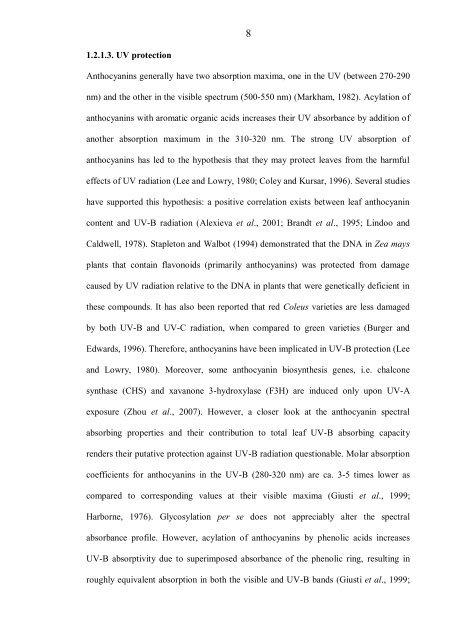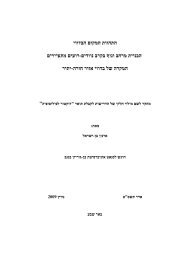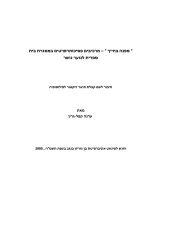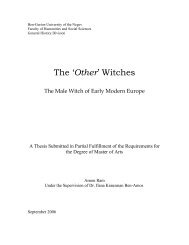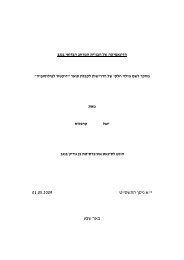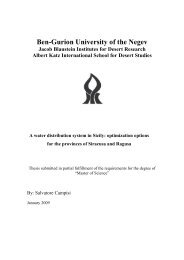Ben-Gurion University of the Negev
Ben-Gurion University of the Negev
Ben-Gurion University of the Negev
You also want an ePaper? Increase the reach of your titles
YUMPU automatically turns print PDFs into web optimized ePapers that Google loves.
1.2.1.3. UV protection<br />
8<br />
Anthocyanins generally have two absorption maxima, one in <strong>the</strong> UV (between 270-290<br />
nm) and <strong>the</strong> o<strong>the</strong>r in <strong>the</strong> visible spectrum (500-550 nm) (Markham, 1982). Acylation <strong>of</strong><br />
anthocyanins with aromatic organic acids increases <strong>the</strong>ir UV absorbance by addition <strong>of</strong><br />
ano<strong>the</strong>r absorption maximum in <strong>the</strong> 310-320 nm. The strong UV absorption <strong>of</strong><br />
anthocyanins has led to <strong>the</strong> hypo<strong>the</strong>sis that <strong>the</strong>y may protect leaves from <strong>the</strong> harmful<br />
effects <strong>of</strong> UV radiation (Lee and Lowry, 1980; Coley and Kursar, 1996). Several studies<br />
have supported this hypo<strong>the</strong>sis: a positive correlation exists between leaf anthocyanin<br />
content and UV-B radiation (Alexieva et al., 2001; Brandt et al., 1995; Lindoo and<br />
Caldwell, 1978). Stapleton and Walbot (1994) demonstrated that <strong>the</strong> DNA in Zea mays<br />
plants that contain flavonoids (primarily anthocyanins) was protected from damage<br />
caused by UV radiation relative to <strong>the</strong> DNA in plants that were genetically deficient in<br />
<strong>the</strong>se compounds. It has also been reported that red Coleus varieties are less damaged<br />
by both UV-B and UV-C radiation, when compared to green varieties (Burger and<br />
Edwards, 1996). Therefore, anthocyanins have been implicated in UV-B protection (Lee<br />
and Lowry, 1980). Moreover, some anthocyanin biosyn<strong>the</strong>sis genes, i.e. chalcone<br />
synthase (CHS) and xavanone 3-hydroxylase (F3H) are induced only upon UV-A<br />
exposure (Zhou et al., 2007). However, a closer look at <strong>the</strong> anthocyanin spectral<br />
absorbing properties and <strong>the</strong>ir contribution to total leaf UV-B absorbing capacity<br />
renders <strong>the</strong>ir putative protection against UV-B radiation questionable. Molar absorption<br />
coefficients for anthocyanins in <strong>the</strong> UV-B (280-320 nm) are ca. 3-5 times lower as<br />
compared to corresponding values at <strong>the</strong>ir visible maxima (Giusti et al., 1999;<br />
Harborne, 1976). Glycosylation per se does not appreciably alter <strong>the</strong> spectral<br />
absorbance pr<strong>of</strong>ile. However, acylation <strong>of</strong> anthocyanins by phenolic acids increases<br />
UV-B absorptivity due to superimposed absorbance <strong>of</strong> <strong>the</strong> phenolic ring, resulting in<br />
roughly equivalent absorption in both <strong>the</strong> visible and UV-B bands (Giusti et al., 1999;


